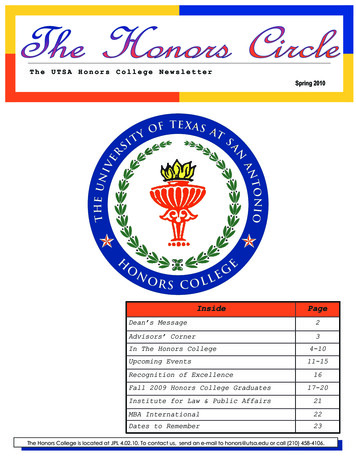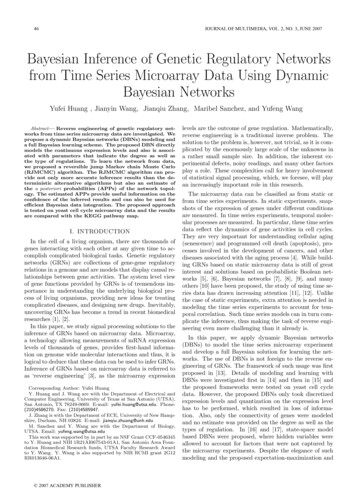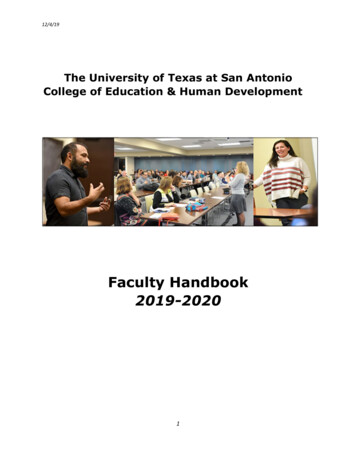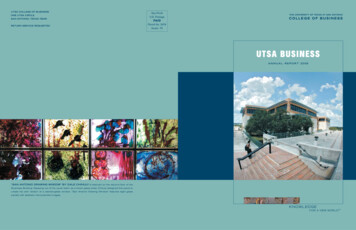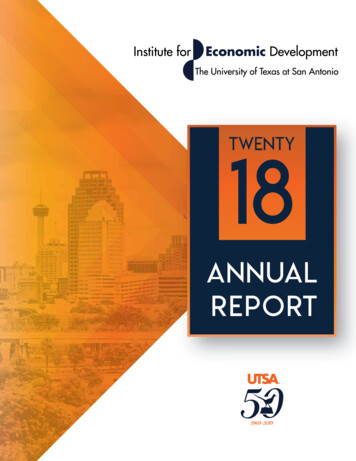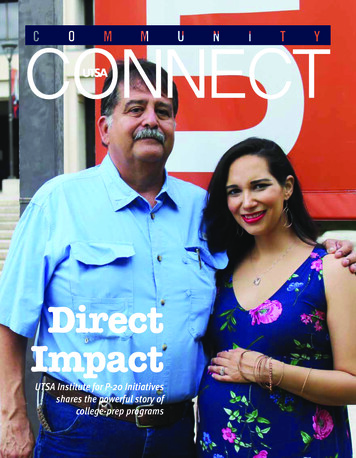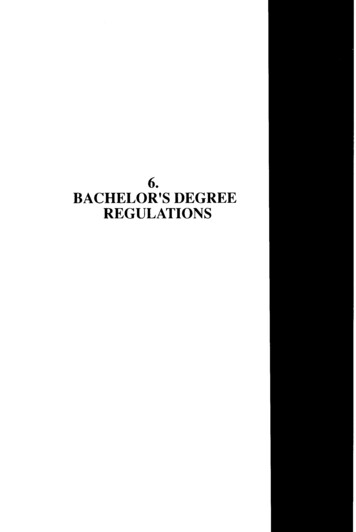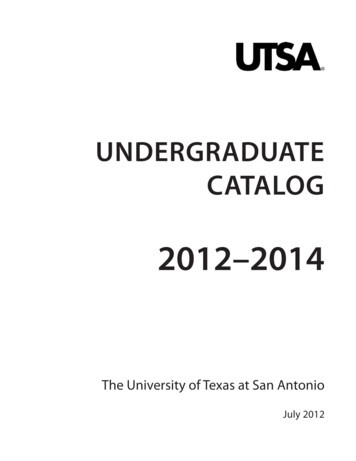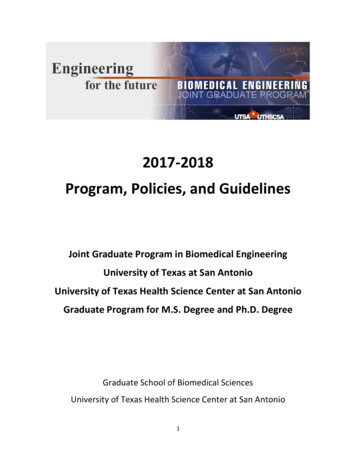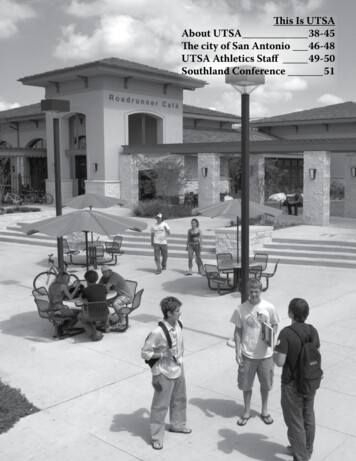
Transcription
This Is UTSAAbout UTSA 38-45The city of San Antonio 46-48UTSA Athletics Staff 49-50Southland Conference 51
IThe University of Texas at San Antonion 1969, San Antonio was a 250-year-old cityfamous for its historic Spanish missions, theRiver Walk and military bases. The Universityof Texas at San Antonio existed only in the mindsof the visionaries who pushed for its creation thatyear by the Texas Legislature.Today, the city and its only public university havereached levels of maturity not even dreamed of40 years ago. With a population of more than1.2 million, San Antonio is the seventh-largestcity in the United States and UTSA is among thefastest-growing universities in the nation with anenrollment of more than 28,500 students.Today, UTSA is on its way to becoming one of thepreeminent public research universities in Texas, aleader in research, education and public service. Asan institution of access and excellence, it embracesmulticultural traditions, serving as a center forintellectual and creative resources as well as acatalyst for socio-economic development for Texas,the nation and the world.HistoryGovernor Preston Smith founded the University of Texas at SanAntonio on June 5, 1969. The university has come a long way in itsfirst 40 years. Administrative offices for the first UTSA president,Arleigh B. Templeton, were set up in 1970 in HemisFair Parkand architects Ford, Powell and Carson, Inc., began developinga master plan for the campus.In 1973 Peter T. Flawn was appointed UTSA’s second presidentand by this time, more than 670 students had enrolled in graduatelevel courses taught by 52 faculty members.UTSA’s earliest students attended college at the KogerCenter office park. Master’s degrees were offered in businessadministration, education, bicultural-bilingual studies, English asThe Main Building on the 1604 Campusa second language, environmental management, Spanish, biology,mathematics and systems design.In 1973 construction began on UTSA’s campus of 600 acres at theintersection of Interstate 10 and Loop 1604 near the northwesternedge of San Antonio. In 1975, with growing enrollment, theuniversity established five colleges: Business, Fine and AppliedArts, Sciences and Mathematics, Humanities and Social Sciencesand Multidisciplinary Studies. One year later, the John PeaceLibrary Building, which also served as the new administrationbuilding, opened.James W. Wagener was named UTSA president in 1978, andin the 1980s, four new colleges were put in place and newundergraduate programs were offered in civil, mechanicaland electrical engineering. Later in the decade, the College ofSciences and Mathematics was reorganized to form the Collegeof Sciences and Engineering. UTSA’s athletics teams alsobegan competing as San Antonio’s only NCAA DivisionI sports program.More than 12,000 students enrolled at UTSA in this eraand a recital hall, University Center, and the first oncampus residence facility, Chisholm Hall, opened. TheInstitute of Texan Cultures, a museum dedicated to thecultural groups that settled Texas, also became a part ofUTSA during this period. Samuel A. Kirkpatrick becamethe school’s fourth president in 1990.The Student Recreation/Wellness Center38The concept for a UTSA Downtown Campus emergedin 1989 when the Texas Legislature expanded highereducation services into the South Texas border region.UTSA received 71.5 million, with 20 million designatedfor the creation of a downtown campus. The site selectedfor the Downtown Campus was the vacated FiestaMall. San Antonio restaurant chain Bill Miller Bar-B-QEnterprises bought the property in 1993 and donated itto UTSA. In January 1994, with a permanent downtowncampus under construction, the university offered2009 UTSA Roadrunners Tennis
The University of Texas at San Antoniocommitment to become a premier public researchuniversity and is the recruiting outstanding facultyand students and forming strategic collaborationswith both public and private partners throughoutthe region, state and nation.Development of new doctoral programs, which aredesigned to address the socioeconomic concernsof the region, is occurring at a rate unmatched byother Texas institutions. In 2000, UTSA offeredfour doctoral programs. In fall 2008 there will be20, to include studies across disciplines in biology,computer science, chemistry, physics, environmentalscience, engineering, English, culture, education,business, applied statistics, applied demography,and anthropology.Student LifeDuring the last five years, students at UTSA haveChaparral Village opened in 2004 and houses more than 1,000 students.supported the expansion of the University Center,the Recreation and Wellness Center, parkingclasses at Cypress Tower on Main Street. Downtown enrollmentfacilities and additional on-campus housing.exceeded 900 students in its first semester. Operations began atthe Frio Street Building in 1997.As the campus environment at UTSA continues to shift fromcommuter to residential, new student housing is coming on-line.Other facilities constructed or opened during the 1990s includedChaparral Village, a 45 million, 1,000-bed housing complex,the Engineering-Biosciences Building, Business Building, aopened in 2004. In November 2006, construction began on thecampus visitor center, and a computer lab. The University Center 39,182,000 Laurel Village project. The first phase opened foralso tripled its original size during that time.the 2007-08 school year, with living quarters for 206 residents.Ricardo Romo became UTSA’s fifth president in 1999 and was In summer 2008, Phase II was completed with an additional 470the first Hispanic president in the university’s 30-year history. beds and a total project covering 185,000 square feet. The twoAcademic reorganization the following year included a move to complexes have increased on-campus residential housing tosix colleges — Business; Education and Human Development; accommodate more than 3,600 students.Engineering; Liberal and Fine Arts; Sciences; and Public Policy. AExpansion of the Roadrunner Café dining facility was completedSchool of Architecture, Honors College and The Graduate Schoolin May 2008, and a new food services provider will bring Wendy’s,were subsequently developed.Chick-fil-A, Panda Express, Taco Cabana and other dining optionsNew construction and additions to the campuses completed in to campus during the 2008-09 academic year.the late 1990s and early 2000s include the Downtown CampusDurango Annex, home of the UTSA Institute for EconomicDevelopment; a 19.3-million Recreation and WellnessCenter; Child Development Center; the Main Building, a 52 million facility on the 1604 Campus; and the 23 millionMargaret Batts Tobin Laboratory Building that will be usedto study emerging infectious diseases.Academic StrengthUTSA serves more than 28,500 students in 64 bachelor’s, 44master’s and 20 doctoral degree programs in the colleges ofArchitecture, Business, Education and Human Development,Engineering, Honors, Liberal and Fine Arts, Public Policy,Sciences and in the Graduate School.As the region’s largest generator of engineers, artists, businessprofessionals, teachers, scientists and technology managers,UTSA has produced more than 76,000 graduates sinceawarding its first degrees in 1974.While continuing to strengthen its undergraduate academicofferings through such initiatives as the Learning Communitiesand expanded student success program, UTSA has made the The University Center is the heart of student activity on the 1604 Campus.goUTSA.com39
The University of Texas at San AntonioA full-service Starbucks openedat the University Center inSpring 2008. The forthcomingexpansion of the UniversityCenter, scheduled to open in Fall2008, adds seven new meetingrooms, a lounge, a ballroomand additional office space forstudent organizations.A new phase of the Recreationand Wellness Center openedin Fall 2007. The 45.7 millionproject renovated 14,505 squarefeet and added 124,710 squarefeet, housing a two-court gym,indoor track, weight room,lazy river, swimming pool andcounseling center.AIDS, SARS, Legionnaire’sdisease, Lyme disease andfood-borne diseases, as wellas microorganisms that may beused as biological weapons. Thecenter has been of particularimportance in light of theevents of Sept. 11, 2001.A view of the San Antonio skyline from the Downtown Campus.In Fall 2007, UTSA studentsapproved an athletics fee referendum to support the expansionof the university’s athletics programs. This is seen as a first step tothe establishment of an NCAA Division I football team at UTSA.Additionally, the university will receive a portion of the city venuetax for the development of a new athletics complex on a 125-acretract recently acquired near the 1604 campus.UTSA currently sponsors 16 sports: baseball, men’s and women’sbasketball, men’s and women’s cross country, men’s and women’sgolf, women’s soccer, softball, men’s and women’s tennis, men’s andwomen’s indoor and outdoor track and field and volleyball. Since1991, UTSA has been a member of the Southland Conference, whichincludes 12 member schools in Arkansas, Louisiana and Texas.Research and Service: Building PartnershipsThere are certain accepted requisites for a city to be considereda “great city” and one of those is a premier public researchuniversity. Though home to six universities, San Antonio remainsthe largest city in the nation without a major research university.UTSA is committed to filling that void by 2016.In the 2007-08 academic year, the university had 586 tenuredand tenure-track faculty positions and more than 630 nontenure-track faculty. The university has 29 endowed positions,including 12 distinguished chairs that are endowed at 1 millioneach. Research and sponsored program funds accounted for 44million in 2007.UTSA has already made great strides in the research arena. Thenewly-opened 83.7 million, 227,000-square-foot Biotechnology,Sciences and Engineering Building is one of the largest sciencerelated educational facilities in Texas. Phases II and III of thefacility, scheduled for completion in 2007 and 2009, respectively,will add 150 million in instructional and research space forundergraduate and graduate programs programs for these indemand academic areas.40UTSA has also established the South Texas Center for EmergingInfectious Diseases. The center focuses research efforts on cholera,Additionally, cyber securityhas become a major area ofresearch at UTSA. The Centerfor Infrastructure Assuranceand Security was designed toleverage San Antonio’s securitystrengths as part of the solutionto the nation’s homelanddefense needs. CIAS continuesto earn national support, withfederal funding of 6.4 millionin 2008.In 2004, UTSA became a major center for demographicresearch with the creation of the Institute for Demographic andSocioeconomic Research. State Demographer Steven Murdockmoved to UTSA as the director of the institute. He was laterselected by President George W. Bush to become the head of theUnited States Census Bureau. Karl Eschbach, who succeededMurdock at the institute, now serves as state demographer.UTSA: Making an Impact on the CommunityUTSA is a crucial component of the state and regional economy.Not only is the university graduating thousands of well-preparedprofessionals into the workforce each year, the institution also istaking a leadership role by partnering with public schools in SanAntonio to increase the number of high school students goingon to college.University events and athletics bring in an estimated 30 millionannually to the San Antonio Metropolitan Statistical Area,including revenue from NCAA Championship events, such asthe 2008 NCAA Men’s Basketball Final Four and 2010 Women’sBasketball Final Four. By the end of the 2009-10 academic year,UTSA will have hosted 11 NCAA Championship events in a13-year period.The university’s impact on the local economy during the past fiveyears has approached 1 billion annually, an amount that shouldincrease dramatically in the next decade.The university’s strategic plan, “UTSA 2016: A Shared Vision,”creates a model for growth over the next eight years. Under thisplan, the university will pursue five strategic initiatives to improvethe value of a UTSA education and emerge as a premier researchinstitution: Enriching Educational Experiences to Enable StudentSuccess; Serving Society through Creativity, Expanded Researchand Innovations; Promoting Access and Affordability; Servingthe Public through Community Engagement; and ExpandingResources and Infrastructure.2009 UTSA Roadrunners Tennis
OPresident Dr. Ricardo Romone of the most decorated athletes in SanAntonio history, Dr. Ricardo Romo hasreturned to his roots and is making UTSAone of the most highly-regarded universities in theregion.and cross country teams and earned All-Americahonors in 1966. Romo was the first Texan to runthe mile in less than four minutes and his mark stillstands as a university record. He earned a bachelor’sdegree in education.Romo became the fifth president of The University ofTexas at San Antonio in May 1999. As President, heleads one of the fastest growing institutions of highereducation in Texas and the nation. UTSA, under hisleadership, is now poised to be one of the state’s nextpremier research universities.Romo holds a master’s degree in history from LoyolaMarymount University and a Ph.D. in history fromUCLA. A nationally respected urban historian, Romois the author of East Los Angeles: History of a Barrio,which is now in its ninth printing (one in Spanish).Romo has led strategic efforts to enhance both access to educationand excellence in scholarship and service at the University.In 1980, President Romo returned to UT Austin toteach history before becoming a Vice Provost for UndergraduateEducation.During his tenure, UTSA’s enrollment has grown nearly 50 percentand the university has added numerous programs and facilitiesto enhance student life. He also has implemented new studentsupport programs designed to help students succeed at earninga university degree. The number of advisers has tripled andUTSA, with more than 28,500 students in 2007-08, is recognizedas a leader in “Closing the Gaps,” a statewide initiative by theLegislature to enroll more Texans in higher education.In 2002, President Bush appointed him to the President’s Boardof Advisers on Historically Black Colleges and Universities. Twoyears later, former Secretary of State Colin Powell appointedRomo as a U.S. representative to the United Nations EducationalScientific and Cultural Organization. The following year, Romowas appointed to the Board of Directors of the Federal ReserveBank of Dallas, San Antonio branch and was reappointed in 2007.Romo currently serves as the Vice Chair.A native of San Antonio’s West Side, Romo graduated from FoxTech High School and attended The University of Texas at Austinon a track scholarship. He served as captain of the track & fieldHe was honored by the UT Austin Friar Society as “OutstandingFriar Alumnus” in 2006. Romo was elected Chairman of the Boardfor the San Antonio Hispanic Chamber of Commerce (the largestU.S. Hispanic Chamber organization) for 2006.In 2007, Governor Rick Perry appointed Romoto serve on the “Commission for College ReadyTexas.” He serves on nearly 20 boards, manyof them in San Antonio and is active in severalmuseum boards and is especially proud of hiswork with the United Way.Romo is married to Dr. Harriett Romo, anassociate professor of sociology at UTSA. Shealso serves as Director of UTSA’s Mexico Centerand works with the Child and Adolescent PolicyResearch Institute. They have one son, Carlos,who graduated from Stanford University andThe University of Texas School of Law. Theirdaughter, Anadelia, attended Princeton as anundergraduate and received a doctoral degreefrom Harvard University and presently teachesat Texas State University.The San Antonio Sports Hall of Fame Class of 2001(l-r): Robert Quiroga, Rudy Davalos, Nelson Wolff and Dr. Ricardo Romo(not pictured: Charley Parker)goUTSA.comDr. Romo has received many honors duringhis academic career. One of the most recentrecognitions was the Isabel la Catolica award, thehighest award given to non-Spanish subjects,bestowed upon him by King Juan Carlos ofSpain.41
AStudent-Athlete Successll too often, the term “student-athlete” ends up justbecoming “athlete.” However, the UTSA Departmentof Athletics takes tremendous pride in the academicachievements of its student-athletes, in addition to theiraccomplishments on the playing field. Several student-athleteshave found a way to successfully balance athletics and academics,defying stereotypical expectations of their roles on the UTSAcampus.This is particularly evident by the number of Roadrunners whohave earned Southland Conference Student-Athlete of the Yearhonors since the award’s inception in 2002. During that time, 13Roadrunners have combined to collect 19 awards.“It is always an honor to have our student-athletes consideredthe best individual in their respective sport when combiningathletics and academics,” Athletics Director Lynn Hickey said.Last fall, Dana Mecke (women’s cross coutnry) won UTSA’sfirst award since Jessica Rogers (softball) collected the honor forthe third time during her illustrious four-year career in 200607. That came on the heels of three UTSA student-athletescollecting four trophies the year before — junior Kurt Attaway(men’s basketball), junior Meagan Daniel (volleyball) and seniorBryan Wolfe (indoor and outdoor track & field) — and an SLCrecord eight Roadrunners earning awards in 2004-05.The award is presented annually to the top student-athlete in eachof the conference-sponsored 17 sports. It is voted on by the headcoaches, sports information directors and academic/complianceadministrators from each SLC school. The winner must haveearned at least a 3.5 cumulative grade-point average to meet theminimum academic requirement. Athletics standards includesuperior achievement, having brought significant recognitionto the institution and having competed in at least two seasons.The final component is the service requirement, for which thewinner must have demonstrated significant contribution to theUTSA Southland ConferenceStudent-Athlete of the Year Honorees2008-09 (1)Dana Mecke Women’s Cross Country2006-07 (1)Jessica Rogers Softball2005-06 (4)Kurt Attaway Men’s BasketballMeagan Daniel VolleyballBryan Wolfe Men’s Indoor Track & FieldBryan Wolfe Men’s Outdoor Track & Field2004-05 (8)Kurt Attaway Men’s BasketballMeghan Chance Women’s Indoor Track & FieldNicole Dunson Women’s BasketballMatt Johnston Men’s GolfAshley McDonald Women’s Cross CountryJessica Rogers SoftballBryan Wolfe Men’s Indoor Track & FieldBryan Wolfe Men’s Outdoor Track & Field2003-04 (2)Meghan Chance Women’s Indoor Track & FieldJessica Rogers Softball2002-03 (3)Svenja Fuhrig Women’s TennisKatie Poindexter Women’s Indoor Track & FieldMike Srp Baseballcampus or community through service.Additionally, UTSA has had five Academic All-Americans, 21ESPN The Magazine Academic All-District VI honorees and61 Academic All-Southland Conference selections the last sixacademic years.UTSA Team AcademicsMission StatementTeam Academics was established in order to provide academic services for student-athletes. We provide the necessary academicsupport services for all student-athletes to be successful in the classroom and pursue an undergraduate degree while competingas an athlete. The center is dedicated to the academic and personal development of all student-athletes.Consistent with the mission of the University of Texas at San Antonio, the Athletic Department is committed to provide anenvironment in which student-athletes can be successful academically, athletically and socially. In doing so, the Departmentdedicates itself to absolute compliance with the rules of the University of Texas System, the University, the Southland Conferenceand the National Collegiate Athletic Association.Vision StatementThe UTSA Athletic Department will be successful in its mission when · Student-athletes achieve academically and compete athletically at the highest level and are prepared with skills for life.· It achieves a level of social responsibility, honesty and integrity higher than is expected by the public and is required by laws,policies, guidelines and rules.· Athletics is the focal point for school identity, pride and spirit among students, faculty, staff, alumni and the surroundingcommunity.· The community benefits from public service, affordable entertainment and economic growth derived from athletics.422009 UTSA Roadrunners Tennis
Roadrunner Athletic FundRoadrunner Athletic Fund — The Team Behind The TeamsThe Roadrunner Athletic Fund, formerly known as the Roadrunner Club, is a non-profit organization thatraises private funds to support UTSA’s 16 intercollegiate athletic programs. Its mission is to effectively buildand sustain quality relationships with alumni, friends and constituents of UTSA Athletics, which in turn,will provide the resources necessary for Roadrunners student-athletes to achieve success and competitiveexcellence – academically, socially, and athletically.Members of the Roadrunner Athletic Fund take pride in having a direct and significant impact on the livesand success of our student-athletes. Whether they are alums or fans — near San Antonio or beyond — theloyal support of our members is critical in helping these young people meet the high academic expectationsat UTSA and compete for championships. In appreciation for their generosity, Roadrunner Athletic Fundmembers are eligible to receive benefits such as ticket discounts and privileges, hospitality, special recognition,communications and invitations.For more information and to join the Roadrunner Athletic Fund and become an important member of ourUTSA Athletics Family, please contact Director of Annual Giving Andrew Haring at 210/458-4665 or visitgoUTSA.com.goUTSA.com43
UTSA SpiritThe School ColorsThe official colors of theUniversity of Texas Systemare orange and white. Uponrecommendation from the UTSAStudent Representative Assembly,the Board of Regents approvedthe addition of navy blue to theorange and white for UTSA’scolors for athletics competition.The MascotThe Roadrunner, a bird representativeof the Texas Hill Country and theSouthwest, was voted the UTSAmascot in 1977, defeating the armadilloin a student election. The choice wasofficially adopted in early 1978.The Alma MaterMusic to “Hail UTSA,” the alma mater ofthe University of Texas at San Antonio,was composed by Professor of Music Dr.Joe Stuessy and the lyrics were written byDirector of the Division of English, Classicsand Philosophy Dr. Alan Craven.HAIL UTSAFrom our hills of oak and cedarTo the AlamoVoices raised will echoAs, in song, our praises flowHail Alma Mater!Through the years our loyalty will growThe University of Texas at San Antonio44The Fight SongGo Roadrunners GoGo, Roadrunners, Go!On to victory with all your mightFight, Roadrunners, Fight!For the Blue and the Orange and the WhiteWe fight for UTSAAlma Mater proud and strongWin, Roadrunners, Win!And unite in our battle song(Repeat for second verse)2009 UTSA Roadrunners Tennis
NCAA ComplianceThe NCAA Rules and FansCompliance with NCAA rules is one of thehighest priorities for our athletics programand institution. As a member of theNational Collegiate Athletics Association(NCAA), the University of Texas at SanAntonio (UTSA) is accountable for theactions of its boosters and fans. Even thebest-intentioned action on a fan’s partmay be a violation of NCAA rules. Pleasecontact the UTSA Compliance Officeif you have any questions concerningwhat is permissible. Inquiries should bedirected to the UTSA Compliance Officeat the address listed below.UTSA Compliance OfficeIntercollegiate AthleticsOne UTSA CircleSan Antonio, TX 78249Phone: (210) 458-5493Representatives of Athletics InterestsA “representative of UTSA’s athleticsinterests,” or booster, is anyone who Has ever participated in or is currentlya member of the various athleticsdepartment support groups. Has made a donation to the athleticsprogram. Has helped arrange summer and/or vacation employment for studentathletes. Has been involved, in anyway, in thepromotion of UTSA’s athletics program.Extra BenefitsProspective and current student-athletesmay not receive extra benefits. An extrabenefit is any special arrangement by aninstitutional employee or representativeof the institution’s athletic interests toprovide a student-athlete or his/herfamily a benefit not authorized by NCAAlegislation. Extra benefits would includebut are not limited to An employment arrangement for aprospect’s relatives. Gifts of clothing or equipment. Cosigning of loans. Providing loans to a prospect’s relativesor friends. Cash or like items. Use of an automobile. Any tangible items, includingmerchandise. Free or reduced-cost services, rentals orpurchases of any type. Free or reduced-cost housing. Use of a college’s athletic equipment. Sponsorship of or arrangement foran award banquet for high school, prepschool or two-year college athletes bya college, athletics representative or itsalumni groups. Employment of a student-athlete at arate higher then the wages paid for similarwork. Payment to a student-athlete for worknot performed.RecruitingOnly coaches and athletics departmentstaff may be involved in the recruitingprocess. Athletic representatives areprohibited from contacting a prospectivestudent-athlete or members of his/herfamily by telephone, letter, e-mail, or inperson for the purpose of encouragingparticipation in athletics at UTSA. ThisgoUTSA.comprohibition remains in effect even afterthe prospect signs a national letter-ofintent (scholarship offer). You can do yourpart by forwarding names of any potentialrecruits to the UTSA coaching staffs.Prospective Student-AthleteA prospective student-athlete is a personwho has started classes for the ninthgrade. You can become a prospect evenif you have not started the ninth grade, ifa college gives you or your relatives anyfinancial aid help or other benefits that itdoes not give others.Before a prospect can make an official visitto UTSA, he/she must present (1) a scorefrom a PSAT, SAT or ACT test (throughan official high school or testing agency),(2) an academic transcript, and (3) mustregister with the NCAA Eligibility Centerand must be placed on the institution’sinstitution request list with the NCAAEligibility Center.Visiting UTSAOfficial VisitAn “official visit” is a visit paid in wholeor in part by the university and cannotexceed 48 hours in length. A prospect canmake a total of five official visits, with alimit of only one per university.Unofficial VisitAn “unofficial visit” is a visit made at theprospect’s own expense. The universitymay provide (a) three complimentarytickets to an on-campus athletics event inwhich the university’s team is competingand (b) transportation to view off-campuspractice and competition sites within a30-mile radius. Prospects can make asmany unofficial visits as they want.More information concerning recruitingand initial eligibility can be found onlineat goUTSA.com or ncaa.org.45
BThe City of San Antonioorn a small Indian campalong the banks of agentle river nearly 300years ago (1718), the city of SanAntonio has grown up into oneof the most diversified cities inthe United States.The city also hosts concerts byall styles of music. Musiciansperform at the Verizon WirelessAmphitheatre, while Broadwaytouring productions perform atthe Majestic Theatre.San Antonio is also a sportstown. It is the home of the fourtime NBA World ChampionSpurs (1999, 2003, 2005, 2007)and four professional sportsfranchises overall. In additionto the Spurs, the Missions areThe Alamo is the top tourist attraction in the state of Texas.a member of the Texas LeagueIt is easy to see why peopleand the Double-A affiliate of thelove the ambiance of San Antonio. Its modern amenities are San Diego Padres. The Rampage compete in the American Hockeyinterwoven into the rich history of the city’s past. A multicultural League, and the newest addition to the professional ranks in Sancenter of the Southwest, San Antonio ranks among the lowest Antonio are the WNBA’s Silver Stars, who opened play in 2003.in cost of living for metropolitan areas with at least one millionpeople. A 1998 survey showed it as 10 percent below the national The city also hosts the Valero Alamo Bowl each December and twoaverage. San Antonio also is a young city. The median age of professional golf events — the PGA Tour Valero Texas Open atits citizens is 32 years old, which is younger than the national the Resort Course at La Cantera Golf Club and Champions TourAT&T Championships at Oak Hill Country Club.average (32.6).A favorite of tourists, the“Alamo City” has kept its smalltown feel while becoming theseventh-largest city in thecountry with more than 1.2million people calling it home.It is a multi-cultural center with seven museums, including thefirst museum of modern art in Texas, the Marion Koogler McNayArt Museum. Historic downtown landmarks include the Alamo,Majestic Theatre, River Walk and Tower of the Americas. Amongall tourist attractions in the state of Texas, the Alamo is rankedas the top attraction, while the River Walk is the second-mostvisited.46The Alamodome has brought numerous sporting events to thecity, including the 1998, 2004 and 2008 Men’s Final
a second language, environmental management, Spanish, biology, mathematics and systems design. In 1973 construction began on UTSA’s campus of 600 acres at the intersection of Interstate 10 and Loop 1604 near the northwestern edge of San Antonio. In 1975, with growing enrollment, the univers
